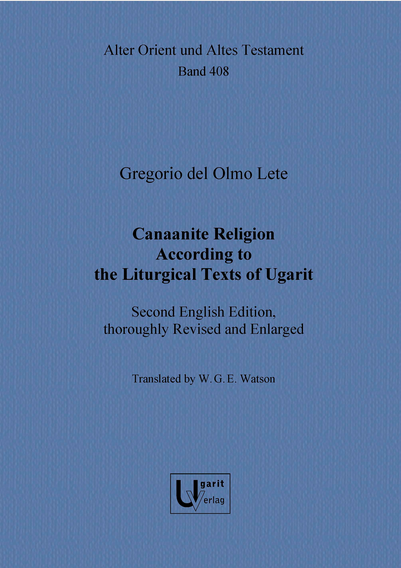 Canaanite Religion According to the Liturgical Texts of Ugarit, 2nd English Revised Edition (Alter Orient und Altest Testament 408), by Gregorio del Olmo Lete, translated by W. G. E. Watson (Ugarit Vorlag, 2014), 423 pages.
Canaanite Religion According to the Liturgical Texts of Ugarit, 2nd English Revised Edition (Alter Orient und Altest Testament 408), by Gregorio del Olmo Lete, translated by W. G. E. Watson (Ugarit Vorlag, 2014), 423 pages.
The Ugarit liturgical texts have received a good amount of attention since their discovery, often because of their significance for the Old Testament. Ugaritic liturgical texts contain word and deed, incantations and sacrifices. The Old Testament does as well, but they are more often separated, as we see cultic instructions in Leviticus 1-7 and praises and song in the psalms, for example.
The importance of these texts makes del Olmo Lete’s book significant for Ugaritic and OT scholars alike. His work was originally published with CDL Press in 1999 and reprinted in paperback by Eisenbrauns in 2004. This second revised English edition brings his work up to date with the latest research. It also appends a lengthy section of “complementary notes” that gives additional commentary to various texts. This kept del Olmo Lete from crowding the page further with lengthy footnotes.
Summary
The introduction covers standard fare, such as the history of research (which is extremely helpful and orderly), a structuralist hermeneutic for cultic literature, the syntax of cultic texts (three basic types of cultic texts are cultic “records,” prescriptive rituals [especially sacrificial offerings], and recited rituals [12]), sacred times, and sacred places, and types of sacrificial rites. His sections on sacred places includes a brief but helpful summary of the archaeological finds relating to the temples of Baal and Dagan in Ugarit.
Chapter 1 lays the groundwork for analyzing the texts by examining the mythological universe of Syria and the Canaanite pantheon, including the eight principal gods of the Baal Cycle and a half dozen other intermediary gods (35). The three sons of Il–Baal, Yam, and Mot–represent the three regions surrounding the earth (sky, sea, and underworld) and are the “epicentre of the pattern and of the resulting mythological conflict around” Baal (37). The predominance of Baal relates to the predominance of rain in Syria-Palestine. Useful charts are scattered throughout the chapter comparing the gods of the Baal Cycle to the gods of the Minor myths and the Hurrian pantheon in Ugarit (42-66).
The rest of the book displays del Olmo Lete’s exegetical labor. Chapters two through seven analyze, respectively, the liturgy of Ugarit, royalty in myth and cult, the funerary cult of the palace, the non-funerary palace cult, the royal liturgy of the Word (prayers and oracles), and the religion of everyday life.
Each chapter examines the main texts involved in each topic, along with full transliterations and translations. The translations are accompanied by a plethora of textual notes and then followed by an exegesis of the text. As he discusses the texts, his extensive familiarity with all the secondary literature is evident. Throughout the book are many full-page pictures of the texts under discussion. The appendix was thankfully placed where it is in order to keep the footnotes fewer than they may have been.
Evaluation
I must commend del Olmo Lete for this extensive and thorough investigation of the Ugaritic liturgy. He brings together a systematic understanding of the cult and of Ugaritic word, magic, and other means of affecting the gods. Those who want to gain an understanding of the Canaanite cult should start here.
Those who want to gain an understanding of the Canaanite cult should start here. Share on XOne might question his structuralist hermeneutic that he applies throughout. Structuralism was popular in literary circles in the twentieth century, especially following the influence of anthropologist Claude Lévi-Strauss. But the idea of a deep structure that carries over between cultures, but which is expressed in various surface structures, is based on what has been shown to be faulty cultural anthropology. That is why deconstruction was an inevitable growth from structuralism, moving, for example, through Roland Barthes and finally to Derrida. Del Olmo Lete uses a structuralist approach to learn much from the epics and myths about the culture and their beliefs, but this hermeneutic likely needs reappraisal.
The one other issue with del Olmo Lete’s work, although it is not unique to him, is the amount of assumption involved in using certain texts to reconstruct rituals. To give just one example, when explaining the enthronement of the new king, he notes that it was “probably” celebrated according to the ritual in KTU 1.132; the place, “although not specified,” must have been the royal palace; it “must be supposed” that the festival began at the new moon (168-172). This sort of “mirror reading,” as we might call it, is frequently undertaken in biblical studies to reconstruct a historical setting, but the amount of assumption and uncertainty when reconstructing the Ugaritic cult is far weightier.
The greatest strength of the work is its close attention to philology and syntax and its systematization of the minute exegetical details into a coherent summary of the rites and liturgies. De Olmo Lete has succeeded in seeing both the forest and the trees. While much speculation is involved, the end result is a fascinating and impressive study of the Canaanite liturgy or Ugarit.
Find it here on Amazon.
